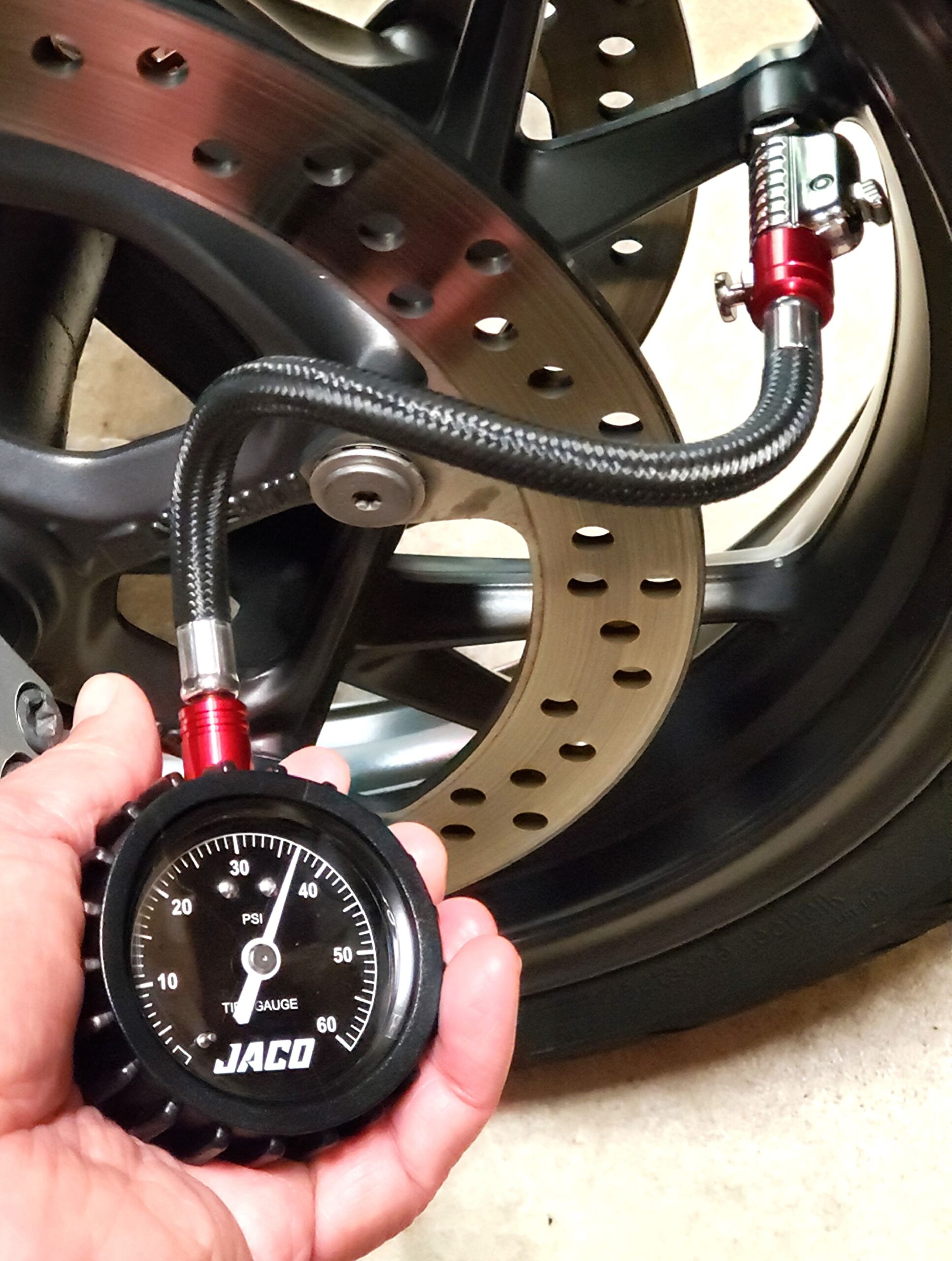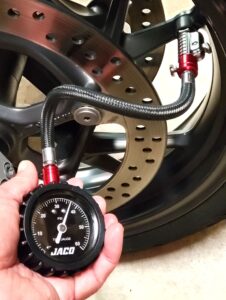Tire pressure may be the most neglected maintenance procedure in all of motorcycling. Back when I was regularly attending AMA races, tire vendors would sometimes go down a long row of parked bikes with a gauge, taking a survey of sorts to see what percentage of riders had inflated their tires properly. It was always a minority, maybe 30-40%, with many tires reading 15 pounds per square inch (psi) low or worse. Maybe those statistics would be a little better now with the advent of TPMS readouts on many newer bikes’ dashboards, but I’d bet the riding community still comes up quite short on this count. Knowing your own habits and those of your riding buddies, what’s your guess? If I’m right, that’s really a shame. Not only is appropriate tire inflation a quick and easy chore, but the stakes can be critical for both handling and safety. Inadequate inflation can cause anything from squirmy steering to rim damage to catastrophic tire failure.
Overinflation is probably much less common because it’s not the result of plain old neglect, as is underinflation. Nevertheless, an overinflated tire can also lead to problems, including a harsh ride, decreased traction and accelerated wear in the tread’s midsection. Remember the MSF pre-ride inspection mnemonic, T-CLOCS? Tires are the first thing to check, and for good reason. They’re our connection to the surface we’re navigating; ignore their condition at great peril.

Obviously, each of us should own a tire pressure gauge. Such tools are available at a stunning breadth of price points, from a few bucks for an old-school pencil-type unit to three figures for the fanciest high-tech versions, perhaps with digital readouts to two decimal places, additional scales and audible alarms for readings outside a user-determined range. Elite racers may notice and be concerned about minuscule increments of pressure, but whole numbers are plenty good enough for the rest of us. Given inevitable variances in calibration, more granular readouts are of dubious credibility, anyway.
Surprisingly, back when I worked for Motorcycle Consumer News, we tested a large assortment of tire gauges to see if higher prices and seemingly more sophisticated technology were actually correlated with greater accuracy. They were not. In fact, when considering performance per dollar, the hands-down winner of that comparison was the humble pencil-type gauge. I’ve owned a multitude of gauges since then, including just about every type on the market, but I never spent a large sum on any one of them as a result of that MCN research.
While I’ve remained skeptical about more money reliably buying greater accuracy, I decided to try a pricier gauge that promised a different benefit. Even if it doesn’t deliver a meaningful advantage in readout precision, JACO’s ElitePro-X tire pressure gauge (discounted from $69.99 to $49.99 with free shipping at time of writing) features a handy “Lightning air chuck” that attaches securely and immediately to a valve stem with a simple push, releases with no significant air escape at the touch of a button, and includes a bleed valve for fine-tuning pressure. Some of my gauges have interfaced poorly with some of my valve stems over the years, and this setup promised to end those (admittedly minor) frustrations. I no longer need to apply lots of perfectly consistent pressure while keeping a fitting exactly aligned with the valve stem in a tight, awkward space to maintain the seal and avoid the dreaded hissing—leakage that often necessitates multiple rounds of pumping to get both the desired pressure and a good, clean reading.
Other common irritants addressed with this gauge are a) no battery failures, since it’s analog; b) very little clearance is required, since the gauge itself is at the end of a flexible 8” braided nylon hose; and c) no bleeding and rechecking only to find the pressure dropped too far and must now be refilled, since this gauge’s bleed valve can be activated while simultaneously watching the gauge. Accuracy, while not guaranteed by a high price, is assured in this case by professional calibration to meet or exceed ANSI standard B40.1 (+/- 1.5%). It features aircraft-grade aluminum alloy construction, a robust rubber shroud and snug swivel fittings at both ends of the hose to provide a durable, high-quality feel. JACO adds a 100% lifetime warranty to further instill confidence. This model even comes with a tough canvas carrying pouch.
In operation, the ElitePro-X works exactly as advertised, although it’s important to avoid squeezing the bleed valve button or release trigger while pushing it firmly into place on the valve stem. This is by no means difficult, but a tiny bit of care must be taken with finger placement. The Lightning chuck pops positively into place, releases just as instantly, and the bleed valve is easy to modulate for precise adjustments. The dial face is clearly readable behind a thick plastic lens (no glass to crack or shatter).
This gauge is available in three different psi ranges: 0-15, 5-60 (my choice), and 5-100. If you don’t need readings approaching or beyond 60 psi, stick with this model to maximize readability. Keep in mind that exposing any gauge to pressure beyond its design parameters can cause damage and/or spoil calibration.
Good tools are a joy to use and the ElitePro-X is no exception. You can certainly find accurate tire pressure gauges for less money, but they’ll likely come with at least some of the annoyances listed above. I wish I’d made this investment earlier so I could amortize its cost over more years, but reducing the number of irritants in my life is worth more as my remaining time diminishes! JACO is a family-owned and -operated U.S.-based company that has been building premium tools since 1983. Explore all their many offerings on their website.







